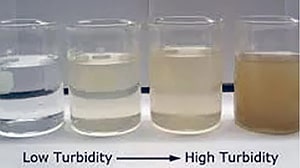Water turbidity refers to how transparent or translucent the water is when examining or testing it for any use.
 Water turbidity can impact food and beverage, municipal, industrial, and aquaculture operations. Turbidity is caused by suspended or dissolved particles in the water that scatter light which causes the water to appear cloudy or even murky.
Water turbidity can impact food and beverage, municipal, industrial, and aquaculture operations. Turbidity is caused by suspended or dissolved particles in the water that scatter light which causes the water to appear cloudy or even murky.
Different particles can cause turbidity, including sediments such as silts and clay, fine inorganic or organic matter, algae or soluble colored organic compounds, and microscopic organisms. Turbidity is measured in a value referred to as NTU, which means Nephelometric Turbidity Unit. The EPA requires a turbidity level no higher than 0.3 NTU in the USA, and if a member of the partnership of safe drinking water, then the level must not exceed 0.1 NTU.
High turbidity can create habitats for other harmful elements, such as bacteria or metals, that can accumulate onto the particles. This increases the health risk for a potable water system. In aquaculture operations, increased turbidity from silts and sediments can harm and harm marine life, so it must be removed to safe levels. For the food and beverage industry, the impact of high turbidity can be both a safety concern and a visual and noticeable quality concern because if the turbidity is high, it can alter the physical look of the final product, for example, a distillery.
When the particle levels are elevated so that only a tiny amount of light can penetrate the water, the turbidity level is considered “high.”
A high turbidity level is typically detrimental to marine life and unacceptable in municipal, industrial, and food and beverage applications. High turbidity also directly impacts operating costs within any sterilization water treatment process. Water containing sediments or clays will often require higher dosing of chemicals such as chlorine as it reacts with the particles in the water. In addition, when utilizing ultraviolet (U.V.) as the method of sterilization, which is common in the food and beverage, municipal, aquaculture, and industrial markets, the higher turbidity readings (NTU) require higher energy levels from the UV system because the light cannot easily penetrate the water. The higher requirement of UV light increases the system's capital costs and will have a much higher electrical cost to produce the UV energy needed to achieve penetration.
At DeLoach Industries Inc., water quality and turbidity levels are examined, and a proper filtration system is designed to reduce the NTU levels. This can include pressure filtration, ion exchange, water softening, and even degasification, followed by micron filtration. The professional design team at DeLoach Industries can assist in reviewing your water quality data and provide a cost-effective and comprehensive solution. Contact DeLoach Industries at 941-371-4995 or sales@DeLoachIndustries.com. For more information on this subject and other technical bulletins, visit the DeLoach website at www.DeLoachIndustries.com.



